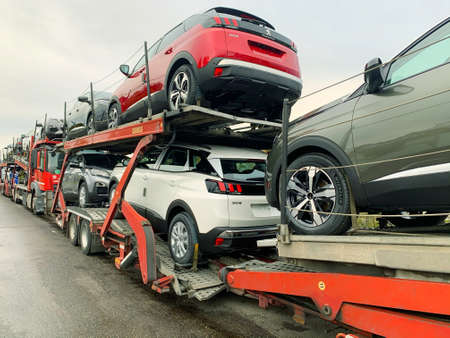1. Introduction
Autonomous vehicles (AVs) have been a hot topic of discussion for years, promising to revolutionize transportation in ways we’ve only imagined. While much of the attention has been focused on how AVs will transform urban areas, their impact on suburban and rural transportation could be just as significant. These areas often face unique transportation challenges, such as fewer public transit options and longer travel distances, making AVs a potential game-changer.
What Are Autonomous Vehicles?
Autonomous vehicles, or self-driving cars, use advanced sensors, artificial intelligence, and machine learning to navigate roads without human intervention. These vehicles come in different levels of automation, ranging from driver assistance features to fully self-driving capabilities.
Potential Benefits for Suburban and Rural Areas
AVs have the potential to address many challenges faced by people in suburban and rural communities. Below are some key benefits:
| Benefit | Description |
|---|---|
| Increased Mobility | AVs could provide mobility solutions for those who dont drive, such as the elderly and disabled. |
| Reduced Transportation Costs | With automation, car ownership may no longer be necessary, reducing costs for individuals. |
| Efficient Public Transit | Self-driving shuttles could fill the gaps in public transit systems, providing better coverage. |
| Less Traffic Congestion | AVs can optimize routes and reduce traffic congestion in suburban areas. |
Challenges to Consider
While AVs have great potential, there are also challenges that need to be addressed. These include:
- Infrastructure Limitations: Many rural roads may need improvements to support AV technology.
- High Initial Costs: The implementation of AVs may require significant investment.
- Regulatory Issues: Governments will need to establish clear regulations and safety guidelines.
The Future of AVs in Suburban and Rural Areas
As technology advances and adoption increases, AVs have the potential to reshape transportation outside of cities. By addressing mobility gaps and making transportation more accessible, AVs could improve the quality of life for many people living in suburban and rural communities.
2. Improving Mobility in Suburban and Rural Areas
Many suburban and rural areas in the U.S. lack reliable public transportation, making it difficult for residents to access jobs, healthcare, and other essential services. Autonomous vehicles (AVs) have the potential to transform transportation in these low-density regions by providing more flexible and accessible options.
Expanding Transportation Access
In areas where bus and train services are infrequent or nonexistent, AVs can bridge the gap by offering on-demand rides. This can be especially beneficial for seniors, people with disabilities, and those without personal vehicles.
Challenges of Public Transit in Suburban and Rural Areas
Traditional public transit struggles in low-density areas because of factors like high operational costs and low ridership. Here’s a comparison of traditional public transit versus AV-based solutions:
| Factor | Traditional Public Transit | Autonomous Vehicles |
|---|---|---|
| Service Frequency | Limited, often hourly or nonexistent | On-demand, available anytime |
| Coverage Area | Fixed routes, limited flexibility | Flexible routes, covering more areas |
| Cost Efficiency | High operational costs, low ridership | Potentially lower costs with optimized routes |
Enhancing First-Mile and Last-Mile Connectivity
A major challenge in suburban and rural transportation is getting residents to and from transit hubs. AVs can serve as a first-mile and last-mile solution, connecting people to major transit stations without the need for personal cars.
Improving Mobility for Specific Groups
- Seniors: AVs can provide a safe and reliable transportation option for older adults who may no longer drive.
- People with Disabilities: Autonomous shuttles can be designed to accommodate wheelchairs and other mobility aids.
- Workers and Students: AV ride-sharing services can help commuters and students access employment and education opportunities more easily.
Conclusion
By offering flexible, affordable, and accessible transportation options, autonomous vehicles have the potential to significantly improve mobility in suburban and rural areas. As AV technology continues to advance, these communities may see a revolution in how people get around.
![]()
3. Economic and Social Impacts
Autonomous vehicles (AVs) have the potential to significantly impact suburban and rural economies by changing how people work, shop, and interact with their communities. These changes could affect local businesses, job markets, and overall community dynamics in both positive and challenging ways.
Effects on Local Businesses
AV adoption could reshape how businesses operate in suburban and rural areas. Reduced transportation costs and more efficient logistics might help small businesses expand their customer base. However, some traditional businesses could struggle if consumer behaviors shift dramatically.
| Potential Benefits | Potential Challenges |
|---|---|
| Increased accessibility to stores and services | Reduced foot traffic for small local shops |
| Lower delivery costs due to automated logistics | Potential business closures if customers shift to more online shopping |
| Opportunities for new AV-based services | Increased competition from larger businesses using automation |
Impact on Job Markets
While AVs may create new types of jobs, they could also replace some existing roles. Workers in transportation, deliveries, and service industries may need to adapt to new opportunities, such as AV maintenance and remote monitoring roles.
Job Sectors Affected
- Transportation – Fewer jobs for traditional drivers but new roles in fleet management.
- Retail & Delivery – Changes in how goods are transported and delivered, affecting logistics jobs.
- Tech & Infrastructure – Demand for software engineers and infrastructure maintenance could grow.
Changing Community Dynamics
AVs could alter how people interact with their surroundings. Improved mobility could enhance social inclusion for seniors and people with disabilities. However, if public spaces become less central to daily life due to increased vehicle convenience, local engagement might decline.
Shifts in Social Structures
- Increased mobility – More freedom for those who currently rely on others for transportation.
- Less dependency on traditional infrastructure – Suburban and rural towns may need to rethink public transit.
- Changes in social engagement – More convenience could mean fewer spontaneous local interactions.
As AVs integrate into daily life, these economic and social shifts will require adaptation from both individuals and communities. While challenges exist, the technology also presents significant opportunities for growth and innovation in suburban and rural areas.
4. Infrastructure and Policy Challenges
Deploying autonomous vehicles (AVs) in suburban and rural areas presents unique challenges that require significant infrastructure upgrades and policy adjustments. Unlike urban centers, where roads are well-maintained and connectivity is strong, suburban and rural regions often lack the necessary support systems for AV operation.
Infrastructure Upgrades
To ensure AVs can operate effectively in less densely populated areas, various infrastructure improvements are needed:
- Road Maintenance: Many rural roads are not well-paved or clearly marked, which can create difficulties for AV sensors and navigation systems.
- Better Connectivity: AVs rely on real-time data and GPS, requiring strong internet and satellite connections, which can be inconsistent in remote areas.
- Charging Stations: If AV fleets include electric vehicles, more charging infrastructure will need to be built in suburban and rural regions.
- Traffic Signals & Signs: Updating traffic signals, signage, and road markings to be AV-compatible will be essential for smoother and safer operations.
Regulatory and Policy Considerations
In addition to physical infrastructure, local and federal policies must adapt to support AV deployment outside cities. Key areas for policy development include:
| Regulatory Challenge | Potential Solution |
|---|---|
| AV Operating Guidelines | Implement clear rules for AV testing, licensing, and day-to-day operation in rural and suburban areas. |
| Liability and Insurance | Define legal responsibilities in accidents involving AVs to ensure fair accountability. |
| Data and Cybersecurity | Establish regulations to protect AV communication networks from cyber threats and ensure data privacy. |
| Public-Private Collaborations | Encourage partnerships between governments and technology companies to accelerate AV-friendly infrastructure deployment. |
Funding and Investment
Expanding AV capabilities into rural and suburban areas will require significant funding. Governments, private investors, and technology firms must work together to support these initiatives. Potential funding sources include federal grants, state-level infrastructure budgets, and private sector investments.
Challenges in Implementation
Despite the benefits AVs can bring to suburban and rural transportation, there are hurdles to overcome, including public skepticism, high implementation costs, and technical limitations in less-developed regions. Addressing these challenges through education, pilot programs, and incremental deployment will be essential for success.
5. Environmental and Sustainability Considerations
How AVs Could Reduce Carbon Emissions
Autonomous vehicles (AVs) have the potential to significantly cut down carbon emissions, especially in suburban and rural areas where driving distances are longer, and public transportation options are limited. By optimizing driving patterns, reducing idle time, and utilizing alternative energy sources, AVs can help create a more sustainable transportation system.
Energy-Efficient Transportation in Suburban and Rural Areas
One of the major benefits of AVs is their ability to improve fuel efficiency. Many AVs are designed to be electric or hybrid, which means they produce fewer emissions compared to traditional gasoline-powered vehicles. Additionally, AVs can drive more efficiently by maintaining steady speeds and optimizing routes, leading to lower fuel consumption.
Comparing Traditional Vehicles and AVs
| Factor | Traditional Vehicles | Autonomous Vehicles |
|---|---|---|
| Fuel Efficiency | Varies, often less efficient | Optimized with AI for better efficiency |
| Emissions | Higher emissions from gasoline engines | Lower emissions, especially for electric AVs |
| Traffic Flow | More congestion and stop-and-go traffic | Smoother driving with fewer sudden stops |
Encouraging the Adoption of Cleaner Energy Sources
As AVs become more common, the shift toward electric and hybrid models will grow. This will reduce reliance on fossil fuels and promote the use of renewable energy. In smaller communities, AVs can be integrated with local charging infrastructure, making sustainable transport more accessible.
Reduced Vehicle Ownership and Shared Mobility
In suburban and rural areas, residents often rely on personal vehicles for daily commutes. However, AV-based shared mobility services, such as autonomous ride-sharing and shuttle programs, can reduce the number of vehicles on the road. Fewer cars mean reduced emissions, lower traffic congestion, and less demand for parking spaces.
The Future of Sustainable AV Transportation
With advancements in autonomous technology and clean energy solutions, AVs have the potential to create a greener future for suburban and rural transportation. By prioritizing energy efficiency and reducing carbon footprints, AVs can play a critical role in sustainable transportation development.
6. Conclusion and Future Outlook
Key Takeaways
Autonomous vehicles (AVs) have the potential to transform suburban and rural transportation in several ways. From improving accessibility and reducing dependency on personal vehicles to offering cost-effective transit solutions, AV integration presents unique opportunities. However, adoption in these areas comes with its own set of challenges, including infrastructure requirements, technological advancements, and public acceptance.
The Future of AVs in Suburban and Rural Areas
Looking ahead, the adoption of AVs in suburban and rural regions will depend on advancements in technology, supportive regulations, and infrastructure development. Here are some key factors that could shape the future of AVs in these areas:
| Factor | Potential Impact |
|---|---|
| Technology Advancements | Improved AI and sensors will enhance navigation in less structured environments. |
| Infrastructure Investment | Better roads and connectivity will support reliable AV operation. |
| Regulatory Support | Clear policies can boost public confidence and encourage deployment. |
| Public Perception | Increased awareness and positive experiences will drive acceptance. |
What to Expect Moving Forward
Over time, we may see AV technology being gradually introduced through pilot programs and ridesharing services. Suburban areas could benefit from seamless first-mile and last-mile solutions, while rural regions could gain improved access to essential services. As infrastructure adapts and technology progresses, AVs have the potential to become a reliable part of suburban and rural transportation networks.


